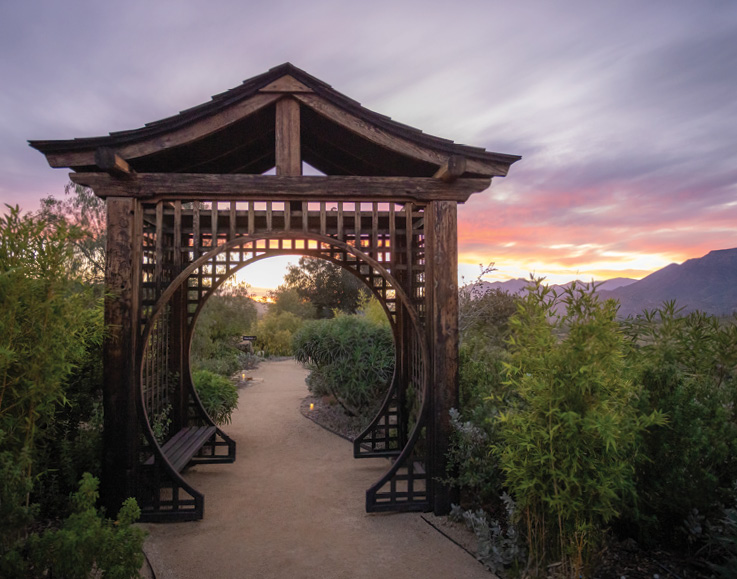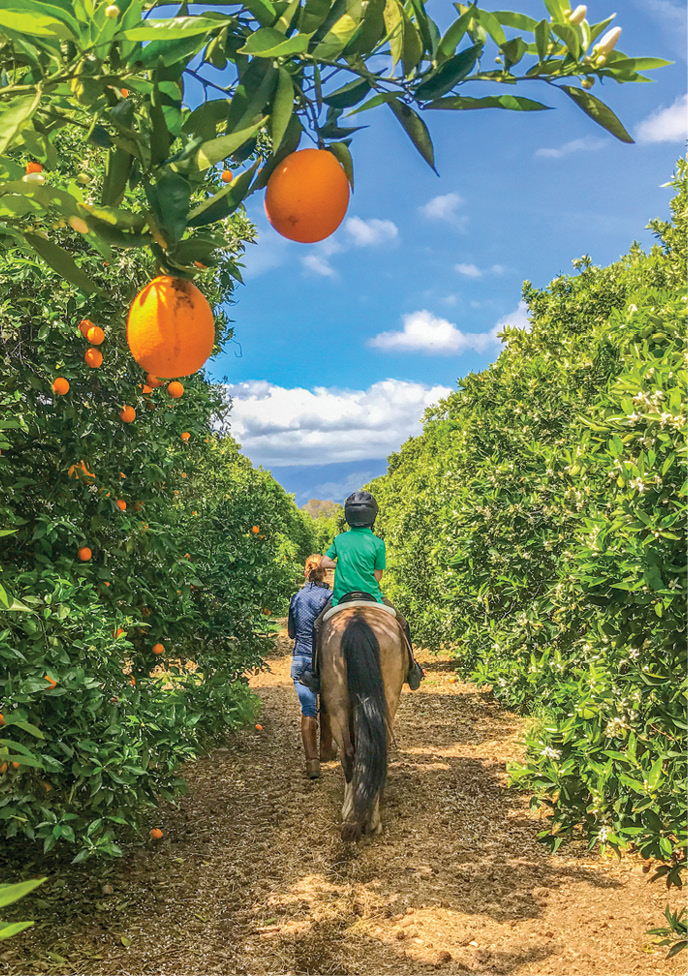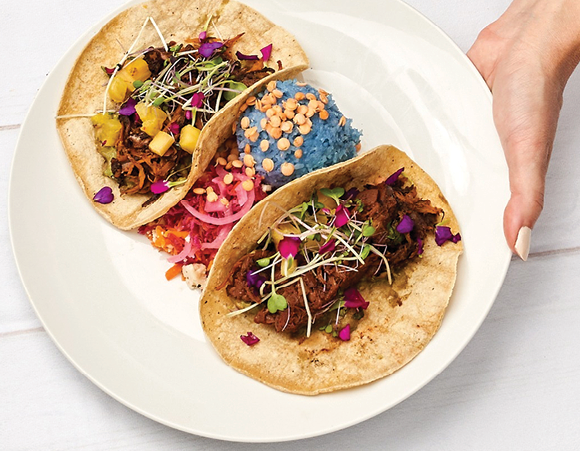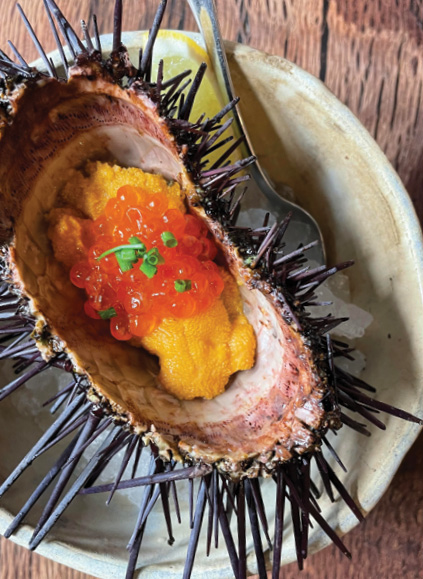Ojai
by Garrick Ramirez
With palm trees and aromatic citrus groves bounded by the soaring Topatopa Mountains, it’s little wonder Ojai is regarded as California’s Shangri-la. Set within a mountain-ringed valley 80 miles northwest of Los Angeles, the diminutive town’s oversized scenery and balmy Mediterranean climate have made it a wellness destination long before a Vitamix whirred its first smoothie. In the 19th century, railroad companies lured passengers with the promise to “Go West and Breathe Again” during an era of widespread tuberculosis. Questionable claims aside, Ojai’s ability to soothe is undeniable. Today, it remains a sun-soaked refuge where you can eat well, bask in striking natural scenery, and yes, breathe easy. Ojai takes its name from the Chumash word “Awha’y,” or “moon,” a testament to the area’s first inhabitants. Yet, it’s the town’s utopian moniker that fuels local lore. When author James Hilton conceived Shangri-la—an enchanting and imaginary valley paradise in his 1933 novel Lost Horizon—he could have been describing Ojai. Adding to the mystique is an alpenglow dubbed The Pink Moment that bathes Ojai in warm hues at sunset, a happy byproduct of the valley’s east-west orientation. The resemblance wasn’t lost on director Frank Capra who came to the valley to film his 1937 adaptation of Hilton’s novel. Never mind that any local footage didn’t make the final cut. When Hilton first visited Ojai, he exclaimed, “This is Shangri-la.”
For Health, Pleasure and Residence
Ojai’s fabled reputation began even earlier with a ploy to boost train ridership after the completion of the transcontinental railroad. Written at the behest of the Central Pacific Railroad in 1873, New York Evening Post editor Charles Nordhoff’s California for Health, Pleasure and Residence extolled the virtues of the sunny region and prompted a migration of wintering visitors. The guidebook proved so influential in shaping Ojai that residents initially named the developing town after the author. One notable visitor drawn by Ojai’s reputed curative powers was a young Jiddu Krishnamurti, the celebrated philosopher who arrived in 1922 with his tuberculosis-stricken brother. Though his brother eventually succumbed to his illness, Krishnamurti fell in love with the town and made it his seasonal home. Over the ensuing years, his lectures on mindful living at his Ojai home drew scores of wellness seekers and practitioners. Many stayed, and Ojai’s culture of wellbeing was enshrined. Today, Krishnamurti’s former home is open to the public as a library and retreat center.


Vibrant Downtown
Downtown Ojai is renowned for whitewashed Mission Revival structures developed in 1917 by Edward D. Libbey, a wealthy Ohioan glass manufacturer and town benefactor who wintered in Ojai during the early 20th century. Inspired by the 1915 Panama-California Exposition, Libbey’s trend-setting designs shunned the prevailing neoclassical style and were soon replicated by neighboring towns such as Santa Barbara. Today, visitors can gaze up at the landmark post office tower, modeled after Havana’s Christopher Columbus Cathedral, and stroll through an arcade filled with shops, wineries and restaurants, all noticeably devoid of chain brands.


On Sunday, the entire town seemingly gathers at a beloved farmers market held a few steps from the arcade. Colorful vendor stands teem with organic produce, local cheeses and fresh-cut flowers. Watch for Ojai Pixies in early spring, and sample the latest pressings from Ojai Olive Oil Company. Located near the entrance to town and along the Ojai Valley Trail, Café BoKU reimagines the pitstop for the 21st century with an inventive plant-based menu, bike tune-up station and rows of EV chargers. You’ll find vegan pastries, nutrient-rich smoothies and entrees such as the BoKU Bowl whose vibrant composition rivals a Matisse canvas with purple sweet potatoes, BBQ jackfruit and a vivid pumpkin seed pesto. As with nearly all Ojai eateries, outdoor picnic tables offer al fresco dining. Come dinner, the intimate Rory’s Place has the feel of a boisterous dinner party with sister-chefs Rory and Meave McAuliffe overseeing a steady parade of oysters, charcuterie and wood-fired dishes from their kitchen. Regional seafood is a highlight with Santa Barbara sea urchin presented in its spiky shell and a whole Channel Islands spiny lobster fire-roasted with Aleppo chile-infused butter.
Ojai notably doesn’t allow vacation rentals, instead offering distinctive, boutique properties such as Caravan Outpost where you’ll bunk in one of ten shiny Airstream trailers tucked in a jungle of Mediterranean palms. The twenty-eight-foot units sport sleek, contemporary interiors with a kitchenette, restroom, shower and delightfully comfy bed. Guests can gather in a central outdoor lounge with a Pixie wheat ale from neighboring Ojai Valley Brewery, or kick back on their greenery-shielded patio with a good book. Complimentary use of yellow cruisers allow guests to zip anywhere in town via the adjacent Ojai Valley Trail. Just like in Ojai, the most rewarding activity might be pausing and simply admiring the verdant surroundings. Owners Shawn and Brad Steward hail from the outdoor apparel world, and are quick to remind visitors of nature’s proven ability to improve one’s mood. It turns out Nordhoff got it right 150 years ago.

Garrick Ramirez is a freelance writer based in San Francisco. He has written for the San Francisco Chronicle, Condé Nast Traveler, Time Out and Visit Santa Cruz magazines about travel, food and city life.

